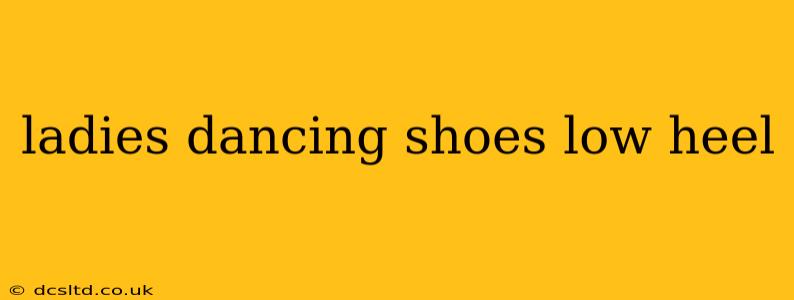Finding the perfect pair of dancing shoes can be a challenge. While high heels offer a certain elegance, many dancers prefer the comfort and stability of a low heel. This guide explores the world of low-heeled ladies' dancing shoes, covering various styles, benefits, and considerations to help you find the perfect fit for your needs.
What are the Benefits of Low-Heeled Dancing Shoes?
Low-heeled dancing shoes offer several advantages over their high-heeled counterparts:
-
Increased Stability and Balance: A lower heel provides a more stable base, reducing the risk of ankle injuries and improving overall balance. This is particularly beneficial for beginners or those who are less confident in their dancing abilities.
-
Enhanced Comfort: The reduced pressure on the ball of the foot and toes contributes significantly to increased comfort, especially during extended periods of dancing. You can enjoy the dance without the pain!
-
Greater Versatility: Low-heeled shoes can often be worn for a wider range of dance styles, from ballroom and Latin to social dancing and even some forms of modern dance.
-
Improved Footwork: Some dancers find that a lower heel allows for more precise and nuanced footwork, giving them better control and agility on the dance floor.
What Types of Low-Heeled Dancing Shoes are Available?
The market offers a variety of low-heeled dancing shoes, catering to different preferences and dance styles:
-
Latin Dance Shoes (Low Heel): Designed for flexibility and responsiveness, these shoes often feature suede soles for grip and a comfortable, supportive fit. The heel height typically ranges from a small wedge to a very low block heel.
-
Ballroom Dance Shoes (Low Heel): Similar to Latin shoes but potentially with a slightly more closed toe design and a focus on elegance and smooth movements. Heel heights vary, but low options are becoming increasingly popular.
-
Practice Shoes: Designed for comfort during rehearsals, practice shoes are often more affordable and less ornate than performance shoes. They typically feature a low heel and durable, comfortable construction.
-
Character Shoes (with low heel option): While traditionally associated with higher heels, some character shoes now offer low heel variations, allowing dancers more stability and flexibility in certain routines.
What Heel Height is Considered "Low"?
"Low heel" is a relative term. In the context of dance shoes, a low heel generally refers to a heel height of one inch or less. This can include a very small wedge heel, a low block heel, or even a barely-there heel.
How Do I Choose the Right Low-Heeled Dancing Shoes?
Choosing the right pair requires considering several factors:
-
Dance Style: The style of dance you'll be performing heavily influences the type of shoe you need. Latin shoes prioritize flexibility, while ballroom shoes may emphasize elegance.
-
Comfort: Prioritize comfort during fittings. Shoes that pinch, rub, or cause discomfort will hinder your performance and enjoyment.
-
Material: Leather or synthetic materials are common choices. Consider the breathability and durability of the material when selecting your shoes.
-
Sole: Suede soles are generally preferred for grip on the dance floor.
-
Fit: Ensure your shoes fit snugly but not too tightly. Your toes should have enough space to move freely.
Are Low-Heeled Dancing Shoes Suitable for Beginners?
Absolutely! Low-heeled dancing shoes are often recommended for beginners as they provide superior stability and balance, minimizing the risk of injury and fostering confidence. The increased comfort also encourages longer and more enjoyable practice sessions.
Where Can I Find Low-Heeled Ladies' Dancing Shoes?
Numerous online and brick-and-mortar dance supply stores carry a wide selection of low-heeled ladies' dancing shoes. It's always a good idea to try on shoes before purchasing to ensure a proper fit.
This comprehensive guide offers a solid foundation for finding the perfect low-heeled dancing shoes. Remember to prioritize comfort, fit, and suitability for your dance style to enhance your experience and enjoyment on the dance floor.
